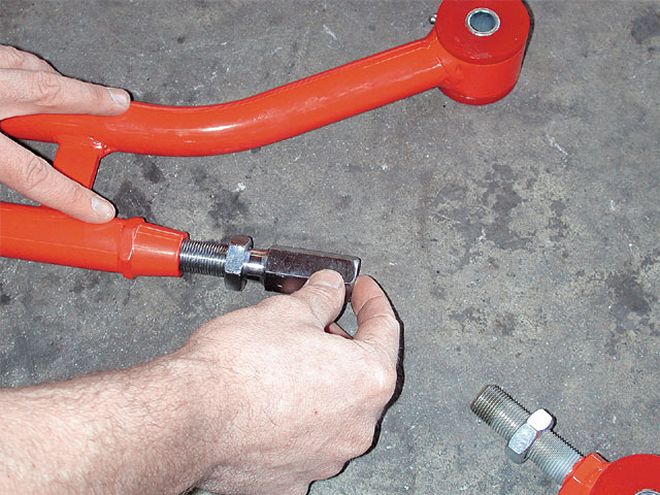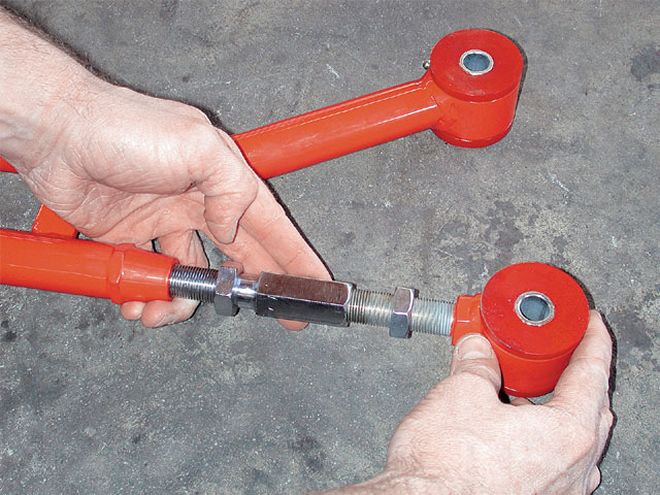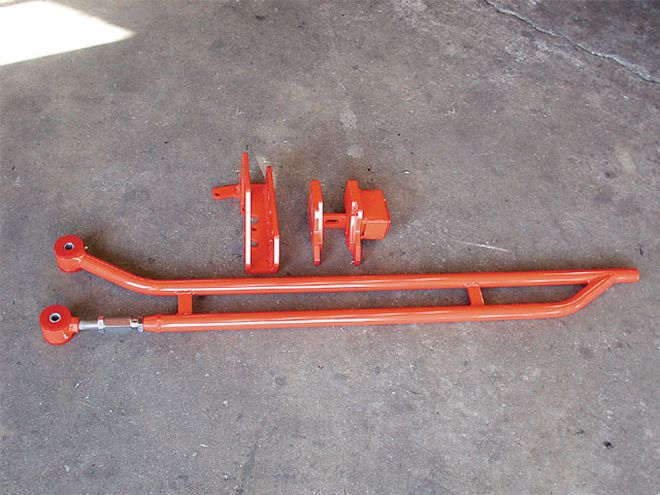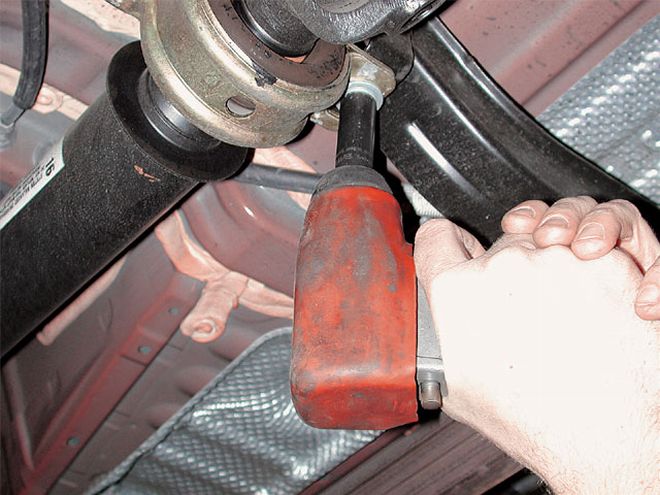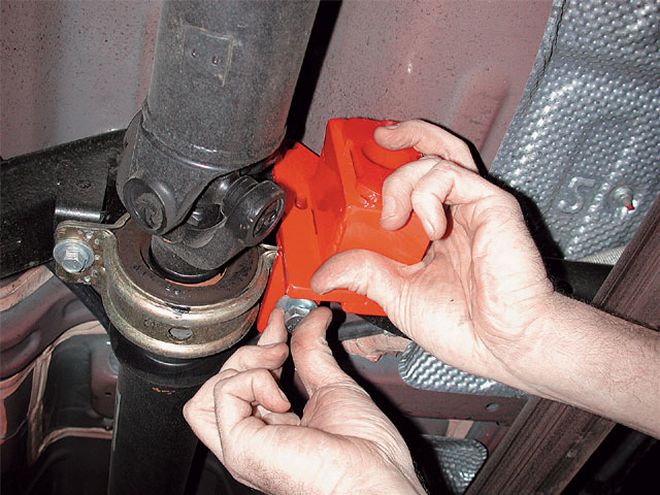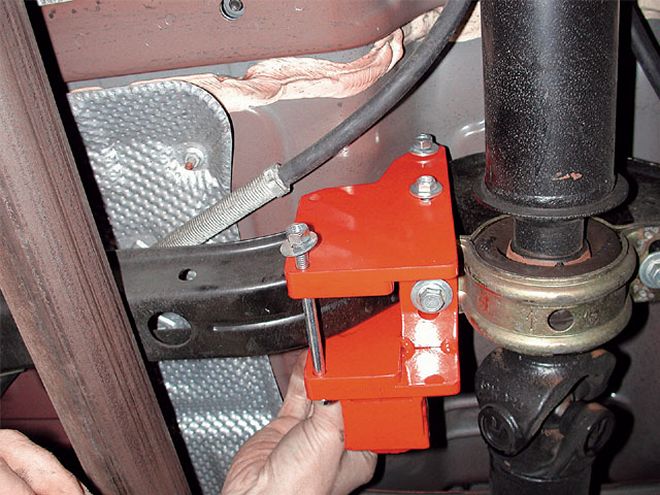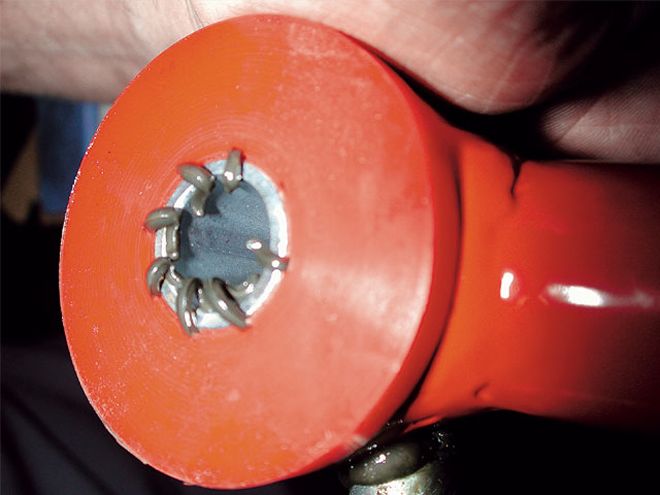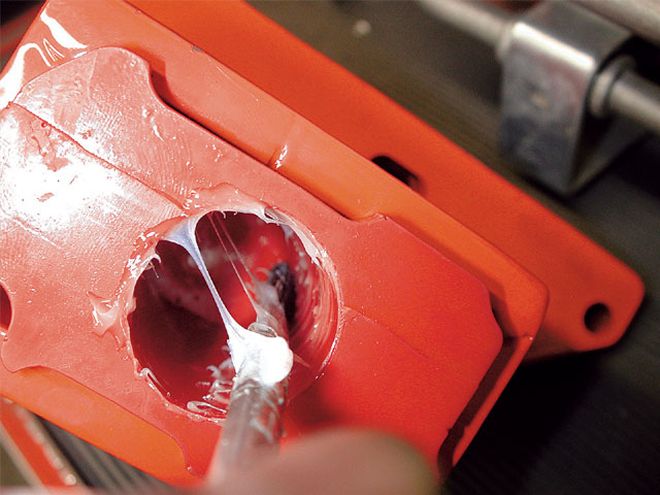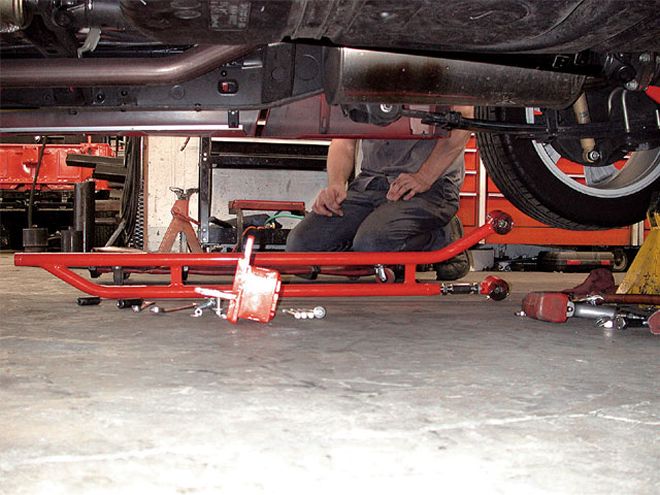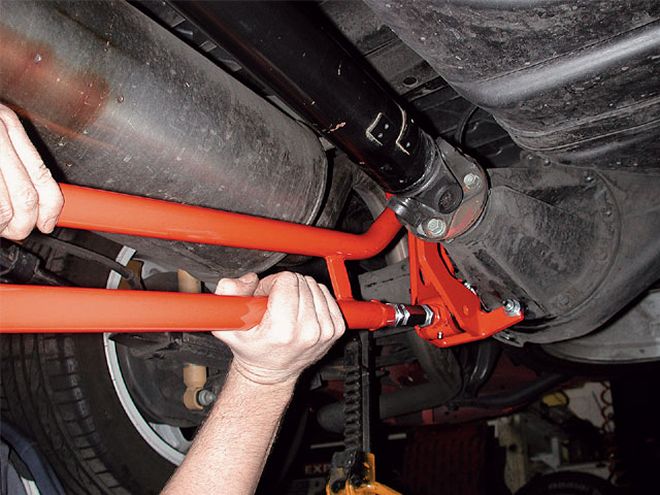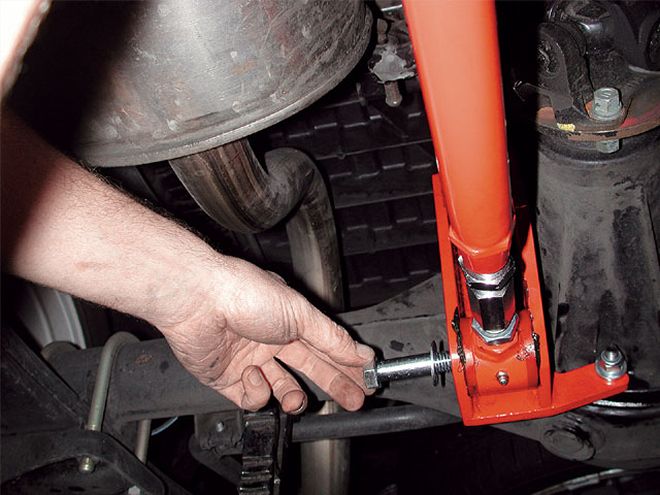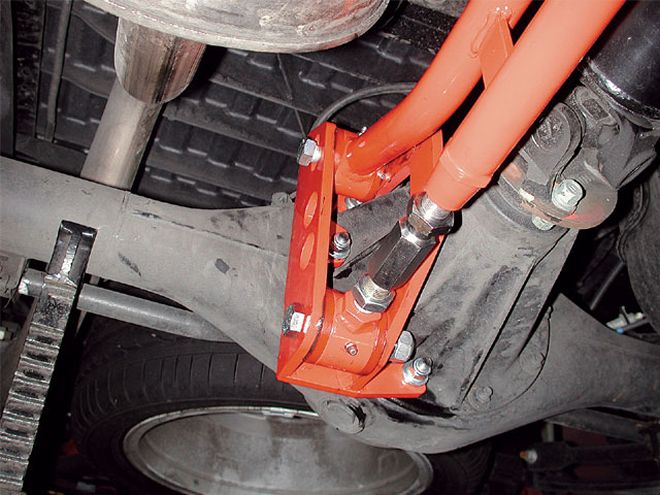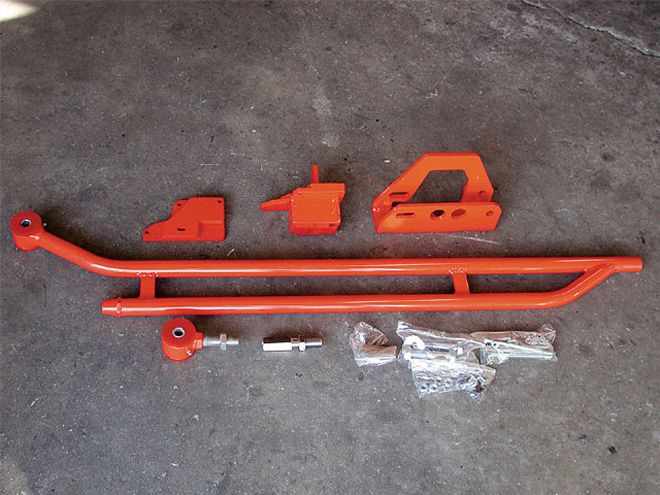
| Here is the bar after we took it out of the box. We paid a little extra for the red powdercoating, but if you don't choose to have it done, it will come in black. The bar comes with all the hardware you need to install it, and it features polyurethane bushings and some extremely stout brackets.
As self-proclaimed performance-minded gearheads, we are always striving to achieve the maximum horsepower from our engines. Whether it's an external or internal component that improves horsepower, we have to have it. But, by creating more and more horsepower we still need to get it to the rear wheels, where it should be. The more we understand about the relationship between engine horsepower, driveline, chassis, and suspension systems of our vehicle the more we can improve not only the engine horsepower but also the handling horsepower of our vehicles. One of the most common problems with ill traction is something we have experienced first hand on our loaner X-Runner: wheelhop. The truck is a well-balanced machine, but the rear springs are just a little too soft to handle the power the truck has stock and we want to add power, which would only make the problem worse. The best way to cure this problem is to first understand the problem. When we mash the throttle, the engine's horsepower is instantly delivered to the differential. As the horsepower and rpm come up, the driveshaft rotates the differential yoke, which is connected to the pinion gear. As the pinion gear rotates, it attempts to climb the ring gear. During this sudden exertion of torque and power, it causes the entire rear axlehousing to rotate backward, in a counter-clockwise direction. This will cause the leaf springs to distort, which cause severe driveshaft U-joint misalignment. During this spring reaction, it unloads the suspension, causing wheelhop. Under a torque load, the axlehousing is allowed to continue to rotate until it meets resistance from the rear leaf springs that will bend and flex into an S-shape trying to snap the axlehousing back to its original position. As the power is increased to the differential, the housing is again allowed to rotate back against the springs. This action/reaction of the suspension is what creates wheelhop, continuing like a tug of war. During wheelhop, the tire's contact patch or traction is lost.
The best way to cure this situation is either a set of slapper bars, which is kind of the old-school way, or a traction bar. Basically, once installed, these components will limit the amount the rearend can rotate, in turn, stopping the action/reaction that causes the hop. What makes the traction bar different than a set of slapper bars is it's a single piece that runs down the center of the truck parallel to the driveshaft, where as slappers bolt under each leaf spring. This design is better because it does what it is supposed to do but will not affect the springs independently. We went back to our friends at Underdog Racing Development (URD) because we were so happy with the company's short-throw shifter. URD has just completed a really bitchen traction bar specifically for the X-Runner, and we could not wait until we could get it on the truck. We went over to Streetshock Altered Suspensions in Torrance, California, and begged Shaughn Reid to clear us a spot in his shop for the install. After a few T-shirts and a couple of posters, he was game. Once installed, the bar did just what URD said it would. Not only can we light the tires up without them hopping all over the place, but we have noticed a definite improvement in the weight transfer and launch of the X.
 | Here is the bar after we took it out of the box. We paid a little extra for the red powdercoating, but if you don't choose to have it done, it will come in black. The bar comes with all the hardware you need to install it, and it features polyurethane bushings and some extremely stout brackets.
As self-proclaimed performance-minded gearheads, we are always striving to achieve the maximum horsepower from our engines. Whether it's an external or internal component that improves horsepower, we have to have it. But, by creating more and more horsepower we still need to get it to the rear wheels, where it should be. The more we understand about the relationship between engine horsepower, driveline, chassis, and suspension systems of our vehicle the more we can improve not only the engine horsepower but also the handling horsepower of our vehicles. One of the most common problems with ill traction is something we have experienced first hand on our loaner X-Runner: wheelhop. The truck is a well-balanced machine, but the rear springs are just a little too soft to handle the power the truck has stock and we want to add power, which would only make the problem worse. The best way to cure this problem is to first understand the problem. When we mash the throttle, the engine's horsepower is instantly delivered to the differential. As the horsepower and rpm come up, the driveshaft rotates the differential yoke, which is connected to the pinion gear. As the pinion gear rotates, it attempts to climb the ring gear. During this sudden exertion of torque and power, it causes the entire rear axlehousing to rotate backward, in a counter-clockwise direction. This will cause the leaf springs to distort, which cause severe driveshaft U-joint misalignment. During this spring reaction, it unloads the suspension, causing wheelhop. Under a torque load, the axlehousing is allowed to continue to rotate until it meets resistance from the rear leaf springs that will bend and flex into an S-shape trying to snap the axlehousing back to its original position. As the power is increased to the differential, the housing is again allowed to rotate back against the springs. This action/reaction of the suspension is what creates wheelhop, continuing like a tug of war. During wheelhop, the tire's contact patch or traction is lost.
The best way to cure this situation is either a set of slapper bars, which is kind of the old-school way, or a traction bar. Basically, once installed, these components will limit the amount the rearend can rotate, in turn, stopping the action/reaction that causes the hop. What makes the traction bar different than a set of slapper bars is it's a single piece that runs down the center of the truck parallel to the driveshaft, where as slappers bolt under each leaf spring. This design is better because it does what it is supposed to do but will not affect the springs independently. We went back to our friends at Underdog Racing Development (URD) because we were so happy with the company's short-throw shifter. URD has just completed a really bitchen traction bar specifically for the X-Runner, and we could not wait until we could get it on the truck. We went over to Streetshock Altered Suspensions in Torrance, California, and begged Shaughn Reid to clear us a spot in his shop for the install. After a few T-shirts and a couple of posters, he was game. Once installed, the bar did just what URD said it would. Not only can we light the tires up without them hopping all over the place, but we have noticed a definite improvement in the weight transfer and launch of the X.
| Here is the bar after we took it out of the box. We paid a little extra for the red powdercoating, but if you don't choose to have it done, it will come in black. The bar comes with all the hardware you need to install it, and it features polyurethane bushings and some extremely stout brackets.
As self-proclaimed performance-minded gearheads, we are always striving to achieve the maximum horsepower from our engines. Whether it's an external or internal component that improves horsepower, we have to have it. But, by creating more and more horsepower we still need to get it to the rear wheels, where it should be. The more we understand about the relationship between engine horsepower, driveline, chassis, and suspension systems of our vehicle the more we can improve not only the engine horsepower but also the handling horsepower of our vehicles. One of the most common problems with ill traction is something we have experienced first hand on our loaner X-Runner: wheelhop. The truck is a well-balanced machine, but the rear springs are just a little too soft to handle the power the truck has stock and we want to add power, which would only make the problem worse. The best way to cure this problem is to first understand the problem. When we mash the throttle, the engine's horsepower is instantly delivered to the differential. As the horsepower and rpm come up, the driveshaft rotates the differential yoke, which is connected to the pinion gear. As the pinion gear rotates, it attempts to climb the ring gear. During this sudden exertion of torque and power, it causes the entire rear axlehousing to rotate backward, in a counter-clockwise direction. This will cause the leaf springs to distort, which cause severe driveshaft U-joint misalignment. During this spring reaction, it unloads the suspension, causing wheelhop. Under a torque load, the axlehousing is allowed to continue to rotate until it meets resistance from the rear leaf springs that will bend and flex into an S-shape trying to snap the axlehousing back to its original position. As the power is increased to the differential, the housing is again allowed to rotate back against the springs. This action/reaction of the suspension is what creates wheelhop, continuing like a tug of war. During wheelhop, the tire's contact patch or traction is lost.
The best way to cure this situation is either a set of slapper bars, which is kind of the old-school way, or a traction bar. Basically, once installed, these components will limit the amount the rearend can rotate, in turn, stopping the action/reaction that causes the hop. What makes the traction bar different than a set of slapper bars is it's a single piece that runs down the center of the truck parallel to the driveshaft, where as slappers bolt under each leaf spring. This design is better because it does what it is supposed to do but will not affect the springs independently. We went back to our friends at Underdog Racing Development (URD) because we were so happy with the company's short-throw shifter. URD has just completed a really bitchen traction bar specifically for the X-Runner, and we could not wait until we could get it on the truck. We went over to Streetshock Altered Suspensions in Torrance, California, and begged Shaughn Reid to clear us a spot in his shop for the install. After a few T-shirts and a couple of posters, he was game. Once installed, the bar did just what URD said it would. Not only can we light the tires up without them hopping all over the place, but we have noticed a definite improvement in the weight transfer and launch of the X.
